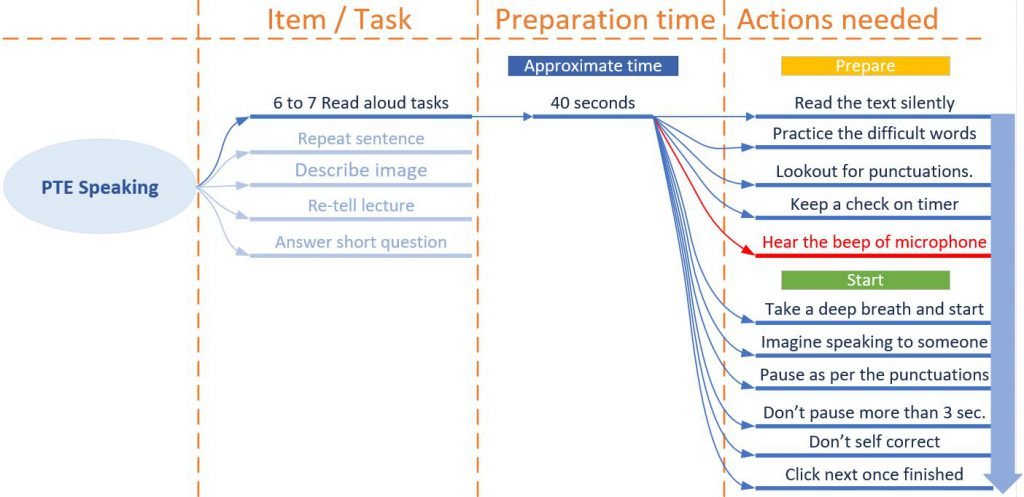
Introduction
Read aloud (PTE) is a task that tests a person’s ability to speak a given text with the right rate of speech, correct intonation, correct stress, and proper pauses in speech to reflect the written punctuations.
There are 6 to 7 read aloud tasks in the PTE exam.
Please memorize the mind map given at the top, these activities need to be followed in the mentioned sequence. It is essential for success.
Scoring
Partial credit
Skills Scored
The Read aloud tasks test the speaking and reading skills of the test taker.
Traits Scored
Read aloud task scores you on 3 parameters
- Content – Your response should include all the words in the text displayed on the screen. Please mirror all the words you see on the screen, do not omit, replace or add your own words as this will negatively affect your score.
- Oral fluency – Your response should be fluent. keep your rate of speech at a medium pace, going too fast will result in mistakes, and going too slow will impact your fluency. Be mindful to stress the right words and intonate. Pause according to the punctuation. Don’t hesitate, to repeat or re-start your response in case of a mistake. Keep going at a steady pace otherwise your score will be impacted negatively.
- Pronunciation – Your pronunciation of words should be correct and with the right stress Otherwise, the AI system will not be able to understand the words and it will negatively impact your scores.
Absolute critical stuff
- Read the text before the microphone opens to identify the stress words, pronounce difficult words, tone, style, purpose, and attitude of the speaker.
- Start speaking within 3 seconds of the microphone opening.
- Don’t pause for more than 3 seconds.
- Don’t add or remove words. Only speak what is there on the screen.
- If you make a mistake, don’t panic and try to correct it by repeating it. Just move ahead as if nothing happened.
The sequence of steps for the read aloud task
The Read aloud task has the following sequence of events:-
- The recording box counts down a timer of 30 to 40 seconds. This is the preparation time you get so make use of this time and do the following actions:-
- carefully read the text on the screen and identify the difficult words in the paragraph.
- try to practice pronouncing the words to get the pronunciation right.
- Next identify the punctuations in the paragraph e.g. commas, full stops, exclamation marks, etc.
- Make a mental note that when you speak the punctuation should reflect in it.
- Keep a check on the countdown timer and stop practising 2-3 seconds before the timer expires.
- Take a deep breath to relax.
- The microphone opens with a beep. Once it opens you have approximately 3 seconds to start speaking before it closes automatically.
- Start speaking calmly. A task started right is already half successful.
- Speak as if you are explaining the text to someone because when we are explaining something we automatically tend to intonate and stress on the right words.
- take your time in pronouncing each word properly and maintain your natural rate of speech.
- Give the correct pauses as per the punctuations e.g. if there is an exclamation your speech should sound surprised. or if there is a comma please give a brief pause and a slightly longer pause for a full stop.
- Don’t correct yourself if you make a mistake, keep going till you finish the task.
- Keep a check on the recording status box to ensure you complete it before the time finishes. There is ample time to complete the task if your rate of speech is not too slow.
- Once you finish reading click next.
Read aloud (PTE) example task.
- Look at the test below. In 40 seconds you must read each text aloud as naturally and clearly as possible. You have 40 seconds to read aloud.
Biofuel is a type of fuel that is produced in a short period from biomass- That is animal waste, plants etc. This material is considered a source of renewable energy as it can be replenished easily. In comparison, fossil fuels take an extremely long period to form and hence are referred to as non-renewable energy sources.
